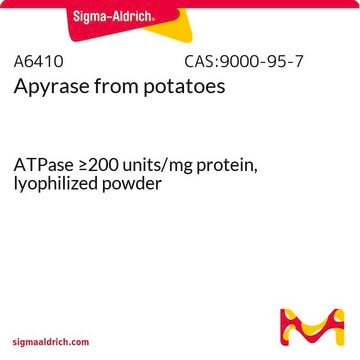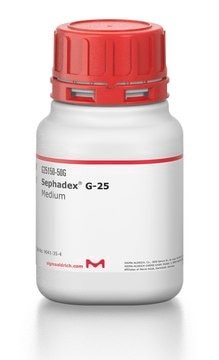A265
ARL 67156 trisodium salt hydrate
≥98% (HPLC), solid, ecto-ATPase inhibitor
Sinonimo/i:
6-N,N-Diethyl-β-γ-dibromomethylene-D-adenosine-5′-triphosphate trisodium salt hydrate, FPL 67156
About This Item
Prodotti consigliati
product name
ARL 67156 trisodium salt hydrate, ≥98% (HPLC), solid
Livello qualitativo
Saggio
≥98% (HPLC)
Forma fisica
solid
Colore
white to off-white
Solubilità
H2O: >20 mg/mL
DMSO: insoluble
Temperatura di conservazione
−20°C
Stringa SMILE
O.[Na+].[Na+].[Na+].CCN(CC)c1ncnc2n(cnc12)[C@@H]3O[C@H](COP(O)(=O)OP([O-])(=O)C(Br)(Br)P([O-])([O-])=O)[C@@H](O)[C@H]3O
InChI
1S/C15H24Br2N5O12P3.3Na.H2O/c1-3-21(4-2)12-9-13(19-6-18-12)22(7-20-9)14-11(24)10(23)8(33-14)5-32-37(30,31)34-36(28,29)15(16,17)35(25,26)27;;;;/h6-8,10-11,14,23-24H,3-5H2,1-2H3,(H,28,29)(H,30,31)(H2,25,26,27);;;;1H2/q;3*+1;/p-3/t8-,10-,11-,14-;;;;/m1..../s1
UWMONIJVKGTUGE-OPKBHZIBSA-K
Informazioni sul gene
human ... ENTPD2(954)
Descrizione generale
Applicazioni
- to prevent ATP degradation during cerebrospinal fluid extraction
- as an ATPase inhibitor in ATP quantification assay for preventing ATP degradation in cytoplasm and mitochondrion
- as an ecto-ATPase inhibitor to treat cancer cells for ATP release assay
Azioni biochim/fisiol
Codice della classe di stoccaggio
11 - Combustible Solids
Classe di pericolosità dell'acqua (WGK)
WGK 3
Certificati d'analisi (COA)
Cerca il Certificati d'analisi (COA) digitando il numero di lotto/batch corrispondente. I numeri di lotto o di batch sono stampati sull'etichetta dei prodotti dopo la parola ‘Lotto’ o ‘Batch’.
Possiedi già questo prodotto?
I documenti relativi ai prodotti acquistati recentemente sono disponibili nell’Archivio dei documenti.
I clienti hanno visto anche
Il team dei nostri ricercatori vanta grande esperienza in tutte le aree della ricerca quali Life Science, scienza dei materiali, sintesi chimica, cromatografia, discipline analitiche, ecc..
Contatta l'Assistenza Tecnica.













